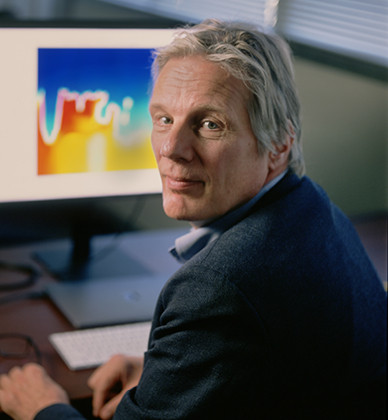Felix Herrmann, Ph.D.
Computational Imaging
Georgia Institute of Technology
Recruited: 2017
Felix Herrmann has made significant innovations in computational imaging, which uses large amounts of data to create an image in situations where you can’t just take a picture.
Herrmann’s work is enabling detailed seismic imaging of the earth’s subsurface at a fraction of the cost of other techniques. This allows oil and gas extraction companies to pinpoint locations of natural resources with less investment in exploration, while reducing harm to the environment. The same techniques could also be used to advance other types of imaging, such as biomedical imaging.
Seismic imaging enhances seismic exploration, or the search for oil, gas and mineral reserves beneath the earth’s surface. To create these images, engineers introduce controlled vibrations into the ground by using dynamite, a pneumatic air gun or a large machine that creates sound waves. The researchers then measure how these vibrations travel beneath the surface of the earth, 10 kilometers deep. They analyze how the sound waves echo and bounce and use the data to determine the kind of material the sound waves encountered.
Seismic imaging is one of the most complex and difficult types of imaging, because the earth’s subsurface is so highly varied and our knowledge of it is limited. Though this imaging problem is challenging, it’s also an essential step before drilling for oil or gas. Drilling a single well can cost as much as $250 million, depending on its depth and location. With these costs, it’s important for oil and gas companies to know exactly where the resources are before they start drilling.
However, seismic surveying is also expensive: It costs between $10 million to $200 million to survey an area of about 100 square miles wide and 10-20 kilometers deep. This is where Herrmann’s innovations are changing the game.
In the early 2000s, a team of mathematicians and computer scientists pioneered a computational technique called “compressive sensing.” Herrmann led this team in applying the theoretical concept of compressive sensing to the real-world problem of seismic imaging, launching an entirely new field. His breakthrough has already made the seismic data acquisition process up to ten times more efficient, reducing its cost and environmental impact significantly.
In contrast to the old approach, which required a dense grid of sampling, compressive sensing uses a much sparser array of samples, then recreates the more densely sampled data using advanced mathematical and computational techniques.
Herrmann and his team have developed and refined techniques for random sampling by fundamentally changing established practices in the field: They’ve found optimization approaches that can provide an accurate image while collecting much less raw data. Since this means less data to process and store, the survey is quicker, cheaper and less damaging to the environment. Their techniques are now being applied by leading companies in the industry.
Another area where Herrmann and his research team have made significant contributions is the field of full wave-form inversion. The technique uses all aspects of data recorded at the subsurface — not just how long it takes the sound wave to echo back, but all the little distortions and changes the waveforms experience on the way. Herrmann has developed techniques that speed up the computations by as much as a factor of ten and that make this technology work even when the initial variables are spotty or poorly defined. These approaches both draw on principles from machine learning.
At Georgia Tech, Herrmann pursues collaborations and public-private partnerships with providers of cloud-based computing, enabling the next generation of computational imaging. His working group brings together experts in mathematics, computer science, geophysics and engineering to solve these problems. And the wealth of cross-disciplinary expertise and resources at Georgia Tech is allowing Herrmann to tackle the greatest imaging challenges in a number of fields.
Research
- Computational imaging
- Seismic data acquisition, processing and inversion
- Wave-equation based imaging
- Compressive sensing
- Large-scale optimization
Straight from the Scholar
“What attracted me to Georgia Tech is there is so much collaboration among different departments. To make progress, we need people who are well-versed in all these different fields. Georgia Tech is also offering me the resources to explore setting up computational ability in the cloud rather than relying on our own cluster, which would be a first for a seismic imaging group.”

